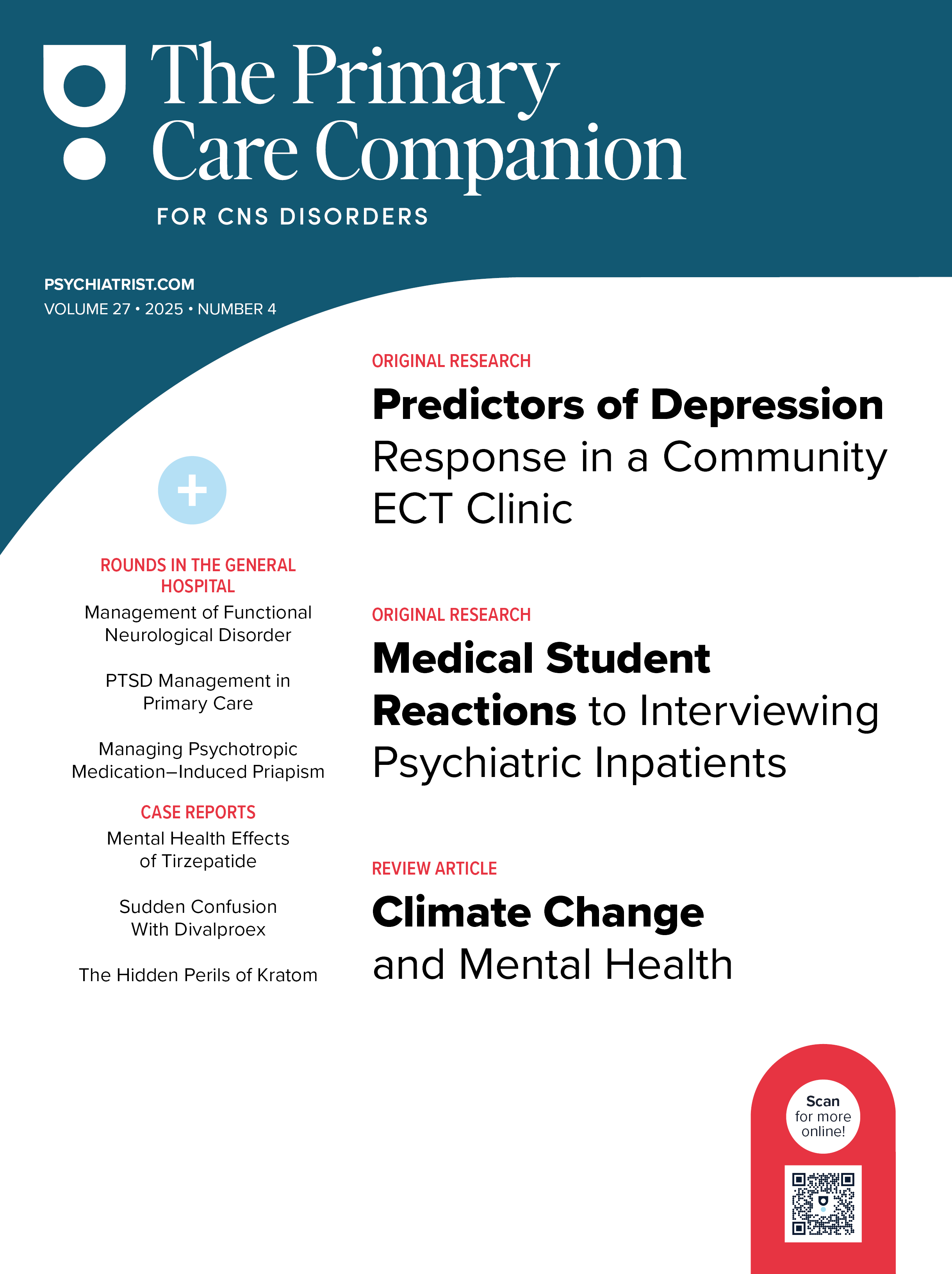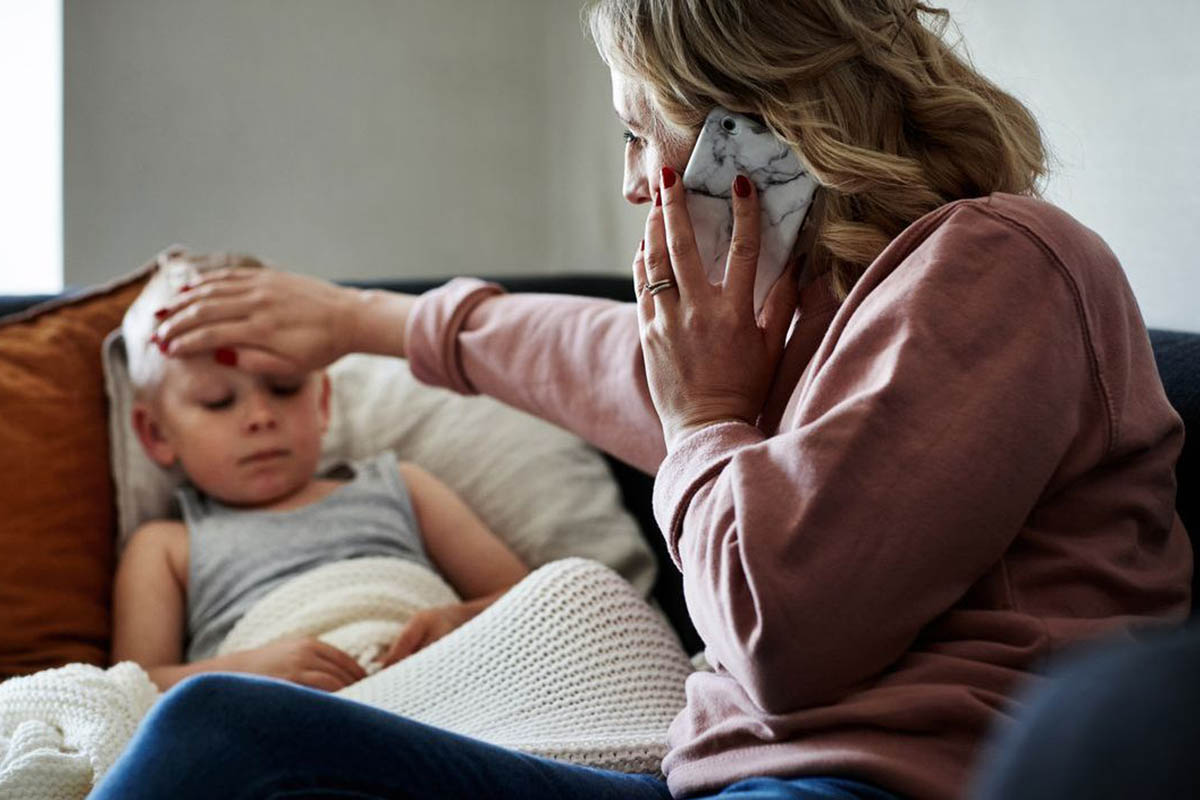See letter by Uvais
Catatonia is one of the most dramatic psychomotor syndromes in medicine. This severe clinical syndrome was first described by Karl Kahlbaum in 1874.1 In the DSM-5, catatonia is strictly differentiated from schizophrenia-related disorders. Catatonia has a vast array of presentations, ranging from agitated ritualized behaviors to a potentially fatal vegetative state.1 The etiologies of catatonia are vast; however, most are attributed to postinfectious causes, mainly in the young age group; longstanding psychiatric illness; and side effects of medications. Patients with catatonia can be complex and challenging to treat due to their extreme social withdrawal and unstable mental state, exemplified by their common food refusal.2
Once legal capacity is introduced into the equation of a catatonic patient, the situation becomes even more challenging. Severely catatonic patients cannot defend themselves or comprehend what transpires in a courtroom, even though those transgressions could potentially dictate their future.3 Defendants who are incompetent to stand trial comprise the largest group of legally committed individuals in US state psychiatric hospitals. The literature suggests a 10%–15% prevalence of catatonia among acute psychiatric inpatients.4 Of these patients, only a small percentage have schizophrenia, demonstrating the need for a change in the traditional definition of catatonia. Mental health professionals conduct approximately 60,000 competency to stand trial evaluations annually in the United States alone, placing a significant burden on state mental health systems.5–7
It is of paramount importance that severely catatonic patients be treated adequately, especially when their saliency is required to resolve their fate. Therefore, the importance of physician beneficence is drastically highlighted in these patients, who would otherwise be affected by this mysterious syndrome.1 In this report, we review the symptoms of catatonia, available treatment options, and unusual response of typical antipsychotics as well as an atypical case presentation. We further identify several areas of uncertainty related to catatonia and competency.
Case Report
Mr A, a young man in his early 20s, was in Department of Corrections custody for charges of robbery in the third degree and burglary in the first degree. He was housed in a mental health observation unit at the correctional facility.
Mr A was referred to hospital medical emergency services for altered mental status and behavior suspicious of catatonia. He was then referred to the comprehensive psychiatry emergency program for forensic evaluation services and was admitted to the prison ward in the hospital. He was later discharged to a correctional facility. After spending 1 day at the correctional facility, he had a similar presentation of social withdrawal and catatonic features, which led him to be rehospitalized in the hospital prison ward.
During this admission, Mr A displayed stupor, catalepsy, mutism, negativism, grimacing, and agitation. These disturbances caused significant impairment in his social functioning. He was started on bupropion and lorazepam. He showed some improvement in the lorazepam challenge test. After a positive response to the medications, lorazepam was downtitrated. Catatonia features aggravated with lorazepam taper; therefore, lorazepam was increased again. The patient was resistant to medical care and had a variable presentation. His clinical features varied from withdrawn and uncooperative to engageable. His orientation ranged from being confused and impoverished to dysthymic and defeated. He seemed to be agitated and internally stimulated.
The patient consented to electroconvulsive therapy (ECT) and had 18 sessions. Olanzapine was started and titrated. He continued to display explicit symptoms of catatonia after undergoing extensive ECT sessions. For further stabilization, Mr A was transferred to the forensic hospital. At initial presentation to the forensic facility, his Bush-Francis Catatonia Rating Scale8 score was > 2. His Bush-Francis severity score was 18. He showed signs and symptoms of retarded catatonia. He was started on haloperidol, lorazepam, clonazepam, and benztropine. As the underlying symptoms of psychosis improved, his Bush-Francis severity score decreased from 18 to 4. Since the patient showed improvement on the Bush-Francis scale, clonazepam and lorazepam were downtitrated and stopped. His mood, social engagement, and gait improved. The patient engaged in conversation with more words per 5 minutes compared to the conversation during admission.
Discussion
Competency to stand trial is firmly rooted in Western law and tradition.9 According to the DSM-5,10 a mental disorder is characterized by a significant disturbance in a person’s cognition, emotion regulation, or behavior. Thus, mental conditions, such as psychotic disorders or intellectual disabilities, negatively influence a person’s cognitive abilities and tend to interfere with their capacity to proceed with trial.5
Patients who are incompetent to stand trial are a particular challenge to clinicians because competency must be restored successfully within a statutorily mandated timeframe. Forensic patients committed to forensic or state hospitals based on incompetence to stand trial have not yet been convicted of a crime and are being involuntarily confined. The explicit purpose of such confinement is to provide treatment that enables them to participate in the trial process.11 In 1960, the US Supreme Court first addressed the standard for competency to stand trial in Dusky v United States.12 Since establishing the Dusky standard, procedures have been developed to determine if a defendant is competent to stand trial. Defendants deemed incompetent to stand trial typically undergo competency restoration consisting of legal education and mental health treatment.11,13
Like any other psychiatric disorder, catatonia in a forensic setting has many roadblocks to diagnosis and treatment. Since patients are psychiatrically unstable, they cannot engage, comprehend the questions, or answer the questions appropriately. It takes quite some time to gather pertinent information for many patients given the lack of collateral and previous psychiatric history, which is crucial to obtain a precise diagnosis.
Also, as discussed previously, competency must be restored in a court-mandated timeframe. For most patients who are incompetent to stand trial, it is difficult to understand and engage in treatment (eg, signing informed consent).
Catatonia is characterized by a cluster of signs and symptoms, including mutism, stupor/immobility, staring, posturing, negativism, withdrawal, rigidity, and autonomic abnormalities.4 Previously, catatonia was considered a subtype of schizophrenia; however, in the DSM-5, catatonia was separated into a syndrome due to its prevalence in numerous disorders, including autism, dementia, intoxication, and general medical conditions.1 There are 2 major subtypes of catatonia: retarded and excited.
Retarded catatonia is associated with characteristics involving paucity of movement, including immobility, staring, mutism, rigidity, withdrawal, and refusal to eat, along with more bizarre features such as posturing, grimacing, negativism, waxy flexibility, echolalia or echopraxia, stereotypy, verbigeration, and automatic obedience. In these patients, the very nature of catatonia can make it challenging, if not impossible, to carry out patient interviews, examinations, and required treatment. The inability to feed oneself or perform daily activities puts these patients in danger of malnutrition and death without treatment and assistance.
The second subtype of excited catatonia is also referred to as malignant catatonia. It is associated with severe psychomotor agitation and could lead to life-threatening complications such as hyperthermia, altered consciousness, and autonomic dysfunction.14 Severe and persistent catatonia can also lead to medical complications, including thromboembolic disease, decubiti, contractures, aspiration pneumonia, malnutrition, and dehydration.15 It is thus crucial to diagnose and treat catatonia expediently.
Catatonic symptoms can often be misunderstood as bizarre psychotic behavior and hence not recognized and treated. As mentioned previously, catatonia has historically been classified as a subtype of schizophrenia, but there is convincing evidence that catatonia is a syndrome that is not limited to such patients. Moreover, improper treatment with antipsychotics can lead to clinical worsening and transition to lethal catatonia/neuroleptic malignant syndrome. Catatonia is thus a syndrome that encompasses both the physiologic and psychological domains.
Despite the complexity and vast array of presentations of catatonia, its treatment is relatively straightforward. Starting in 1930, it was discovered that sodium amobarbital (a barbiturate) rapidly relieved catatonia. More recently, benzodiazepines have taken the place of barbiturates due to their effectiveness and less severe side effect profile. Studies2 have shown that benzodiazepines relieve/reduce catatonia in 80% of subjects. Part of the process for catatonia diagnosis involves a “lorazepam challenge,” in which 1 to 2 mg of lorazepam is given to see if the catatonic symptoms subside.16 For patients who are refractory to benzodiazepines, ECT can be used.
The benefit of inducing seizures to relieve catatonia was first discovered in 1934, and by 1940, ECT was used universally to treat not only catatonia but also various psychiatric illnesses.2 One drawback of ECT, however, is that consent is required, and since most catatonic patients cannot provide consent, a surrogate must be used, which is sometimes difficult to acquire in the forensic setting. In patients experiencing malignant catatonia, ECT should be considered the first-line treatment over benzodiazepines due to the severity associated with prolonging the symptoms. Other additional treatments have been shown to have some success in treating catatonia, including zolpidem and memantine, and their efficacy is still being studied.2,14 While there has been success in treating catatonia, there remains significant room for improvement in preventing its occurrence and controlling more complex cases.
The relationship between antipsychotic medication and neurologic abnormalities is more complex than previously acknowledged, since antipsychotic drugs may both improve preexisting abnormalities and cause “de novo” neurologic syndromes. Overall, olanzapine has a more favorable neuromotor profile than risperidone, which has a better profile than haloperidol.17 No literature was found showing the effect of typical antipsychotics on the symptoms of catatonia.
Conclusion
There is a paucity of literature that shows the efficacy of typical antipsychotics for the treatment of catatonia. Our case is a novel report of a patient who showed promising improvement with a typical antipsychotic. We found in our review of the literature that lorazepam, a benzodiazepine, is the most popular treatment for catatonia, despite other successful treatments. When a rapid response is required in severe cases, ECT should be initiated. Antipsychotic medications can be used on a case-by-case basis, but further studies need to be conducted on a larger scale.
Article Information
Published Online: August 24, 2023. https://doi.org/10.4088/PCC.22cr03477
© 2023 Physicians Postgraduate Press, Inc.
Prim Care Companion CNS Disord 2023;25(4):22cr03477
Submitted: December 22, 2022; accepted February 24, 2023.
To Cite: Gill G, Segal Y, Yadav G, et al. Catatonia and competency to stand trial with unique response to haloperidol. Prim Care Companion CNS Disord. 2023;25(4):22cr03477.
Author Affiliations: Department of Psychiatry, Bronx Care Health System, New York (Gill, Segal, Yadav, Riess); Stony Brook University, New York (Kainth); St. George School of Medicine, Grenada, West Indies (Zachary).
Corresponding Author: Gurtej Gill, MD, Department of Psychiatry, Bronx Care Health System, 1267 Fulton Ave, Fl 5, Bronx, New York 10456 ([email protected]).
Relevant Financial Relationships: None.
Funding/Support: None.
Patient Consent: Consent was obtained from the patient to publish the case report, and information has been de-identified to maintain anonymity.
References (17)

- Walther S, Strik W. Catatonia. CNS Spectr. 2016;21(4):341–348. PubMed CrossRef
- Fink M. Clinical practice to change with divorce of catatonia and schizophrenia. J Clin Psychopharmacol. 2013;33(3):287–288. PubMed CrossRef
- Murrie DC, Gardner BO, Torres AN. Competency to stand trial evaluations: a state-wide review of court-ordered reports. Behav Sci Law. 2020;38(1):32–50. PubMed CrossRef
- England ML, Ongür D, Konopaske GT, et al. Catatonia in psychotic patients: clinical features and treatment response. J Neuropsychiatry Clin Neurosci. 2011;23(2):223–226. PubMed CrossRef
- Gay JG, Vitacco MJ, Ragatz L. Mental health symptoms predict competency to stand trial and competency restoration success. Leg Criminol Psychol. 2017;22(2):288–301. CrossRef
- Bonnie RJ, Grisso T. Adjudicative competence and youthful offenders. In: Grisso T, Schwartz RG, eds. Youth on Trial: A Developmental Perspective on Juvenile Justice. University of Chicago Press; 2000:73–103.
- Morris DR, Deyoung NJ. Psycholegal abilities and restoration of competence to stand trial. Behav Sci Law. 2012;30(6):710–728. PubMed CrossRef
- Bush G, Fink M, Petrides G, et al. Catatonia, I: rating scale and standardized examination. Acta Psychiatr Scand. 1996;93(2):129–136. PubMed CrossRef
- Callahan L, Pinals DA. Challenges to reforming the competence to stand trial and competence restoration system. Psychiatr Serv. 2020;71(7):691–697. PubMed CrossRef
- American Psychiatric Association. Diagnostic and Statistical Manual of Mental Disorders: DSM-5. American Psychiatric Publishing; 2013.
- Bartos BJ, Renner M, Newark C, et al. Characteristics of forensic patients in California with dementia/Alzheimer’s disease. J Forensic Nurs. 2017;13(2):77–80. PubMed CrossRef
- Juvenile Competency Attainment Research & Development Center. Dusky v United States, 362, US 402 (1960). University of Virginia website. Accessed July 25, 2023. https://juvenilecompetency.virginia.edu/legal-precedents/dusky-v-united-states
- Gay JG, Ragatz L, Vitacco M. Mental health symptoms and their relationship to specific deficits in competency to proceed to trial evaluations. Psychiatry Psychol Law. 2015;22(5):780–791. CrossRef
- Rasmussen SA, Mazurek MF, Rosebush PI. Catatonia: our current understanding of its diagnosis, treatment and pathophysiology. World J Psychiatry. 2016;6(4):391–398. PubMed CrossRef
- Wortzel JR, Maeng DD, Francis A, et al. Prevalent gaps in understanding the features of catatonia among psychiatrists, psychiatry trainees, and medical students. J Clin Psychiatry. 2021;82(5):21m14025. PubMed CrossRef
- Rosebush PI, Mazurek MF. Catatonia and its treatment. Schizophr Bull. 2010;36(2):239–242. PubMed CrossRef
- Peralta V, Cuesta MJ. The effect of antipsychotic medication on neuromotor abnormalities in neuroleptic-naive nonaffective psychotic patients: a naturalistic study with haloperidol, risperidone, or olanzapine. Prim Care Companion J Clin Psychiatry. 2010;12(2):PCC.09m00799. PubMed CrossRef
Please sign in or purchase this PDF for $40.




